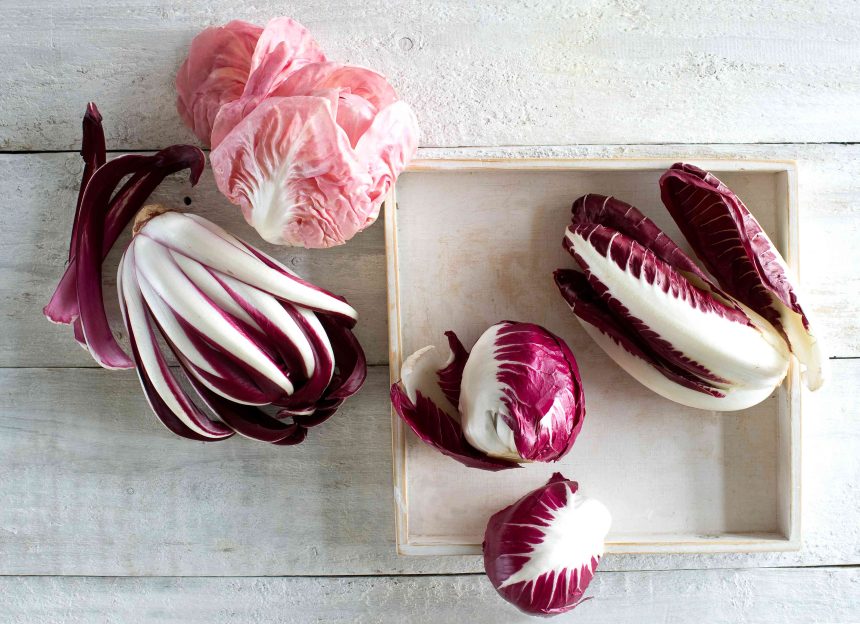Radicchio is the “it girl” of the winter season. A type of chicory, radicchio is unique in just about every sense of the word, from its characteristic bitter flavor to the gorgeous look of each variety. It can be served raw or cooked and needs only a few other seasonal flavors to make it shine. Radicchio thrives in frigid temperatures that many other crops cannot survive, making it a mainstay ingredient in numerous winter recipes, from fresh salads to grilled or roasted wedges as a side.
Ahead, learn about the main varieties of radicchio. We’ll also share some of our favorite ways to prepare this wonder vegetable, which promises to bring a pop of color to meals on even the gloomiest days.
Franco Fubini, CEO and founder of Natoora, a seasonal produce supplier working directly with over 600 small-scale farmers and over 2,000 restaurants worldwide
What Is Radicchio?
Radicchio is a chicory plant that has been cultivated in Italy for centuries, says Franco Fubini, CEO and founder of Natoora, a produce retailer that sources directly from farmers. Historically, each area had its own variety. These origins are now reflected in the names of different varieties such as Treviso, Castelfranco, and Chioggia.
Today, radicchio is grown in other countries, but the radicchio plant and the traditions surrounding it are still a vital part of Italy’s cultural identity. The plants are well suited to the cold winters and help protect the sandy soils at a time of year when other crops are sparse. Proper growing practices also mellow out the notorious bitterness of the radicchio plant, making it perfectly palatable.
About Radicchio’s Bitterness
Justin Walker
You might have heard that radicchio is bitter, which may have put you off trying this winter favorite. Let us explain and tempt you to try radicchio. Its bitter edge boils down to science—a chemical compound in the plant is naturally released when the leaves are broken down.
How It’s Grown
The level of bitterness in each radicchio variety depends on the cultivation method that a grower uses, says Fubini. For example, the small-scale growers he works with wait until the first frost to transplant their chicories for a second growing stage, which is the crucial time when the plants will fully mature. This is more labor-intensive but produces radicchio that, while naturally bitter, will have a crisp texture and a complex, bittersweet flavor. Most commercial growers use seeds designed to “self-blanch” or reach their color in the field without a second intervention. The result of self-blanching varieties tends to be a duller color, drooping texture, and a more pronounced bitter flavor.
There is a third method of radicchio cultivation, the forced growing technique, where the plants are harvested with their roots intact and moved to an area that adds heat and blocks out light. The plants then come back to life but cannot photosynthesize, giving them a perfect not-too-bitter flavor profile.
Embrace the Bitterness (Or Temper It)
Beyond the harvesting technique and radicchio variety, the level of bitterness also varies depending on how you prepare it. When served raw, radicchio will naturally be more bitter. When cooked, some of the natural sugars are released, mellowing the bitter flavor.
Much like onions, soaking chopped radicchio in cold water can help temper the bitterness a bit. This is particularly helpful if you’re eating the radicchio raw.
Types of Radicchio
Come November, you’ll start to see a mix of different chicories pop up at grocery stores and farmers’ market stands. Here are the five main types to keep on your radar:
- Chioggia: This variety resembles a small head of red cabbage (on the outside and inside), and you’ll find it at pretty much any supermarket. It is known for adding a bit of an astringent bite to dishes.
- Castelfranco: This variety is known for its unmistakable speckled leaves. They tend to be a very pale green color and have a much more mild, creamy flavor than other radicchio varieties, making them the perfect green to use in a simple salad.
- Treviso: Oblong in shape, the Treviso leaves are similar in style to Chioggia, but they have a more mild overall flavor. We like to add them to crudité platters since they are perfect for scooping up dips and sauces or as a vessel for cheese and charcuterie meats.
- Tardivo: This gorgeous variety of radicchio is known for its deep purple leaves that curl around the head of the vegetable. It is a hearty variety that goes through a second stage of growth. This step is often skipped in commercial growing, but it produces a more genuine flavor and a sturdier leaf.
- Rosa del Veneto: The leaves of this rosy pink variety take some time to develop their color. As such, they tend to be more of a specialty variety. The leaves are tender and mildly bitter with a hint of sweetness. We like to serve them raw to preserve their pink hues.
Using Radicchio
- Raw: Raw chicories are delightful in any kind of winter salad you can think of. Use a mix of your favorite varieties to add a pop of color to warm bread salad or feature it on its own, adorned with a simple dressing. Fatty Parmesan cheese can help balance bitter raw radicchio in salads. When sliced thin, radicchio is also delicious atop warm chicken cutlets—the leaves will wilt against the heat and become very pleasant.
- Cooked: Radicchio, especially the more bitter varieties, can benefit from being cooked. This could be anything from letting the greens wilt into warm pasta or roasting wedges in a hot oven. Most varieties will hold up well to heat, so they remain aesthetically pleasing when sautéed or grilled.
Flavor Pairings
What grows together goes together—that couldn’t be more true in this case. Other winter ingredients are what naturally pair best with radicchio. Since these greens are on the bitter side, pairing them with other ingredients that are sweet, acidic, and/or fatty will bring out all of their best flavors.
- Sweet: Honey, maple syrup, apple cider, dried fruits
- Acidic: Citrus juice, vinegar, mustard, capers, olives
- Fatty: Nuts and seeds, cheese, bacon or pancetta, anchovies, butter, and olive oil
Storing Radicchio
Properly storing radicchio will help it stay fresher and last longer. Fubini recommends covering the heads with an opaque material like a plastic bag and storing them in the refrigerator to prevent further photosynthesis.
How to Prep Radicchio
Start by checking the recipe—do you need to slice the leaves, or are they served whole? If you’re using whole leaves, simply remove them one by one and discard any of the outer leaves that look wilted or have brown spots.
If the recipe calls for sliced or chopped radicchio, slice the whole head in half and cut out the white core at the bottom. From there, slice or chop as desired.
For either application, you can rinse or blot off any dirt or grit that you see on the leaves.







